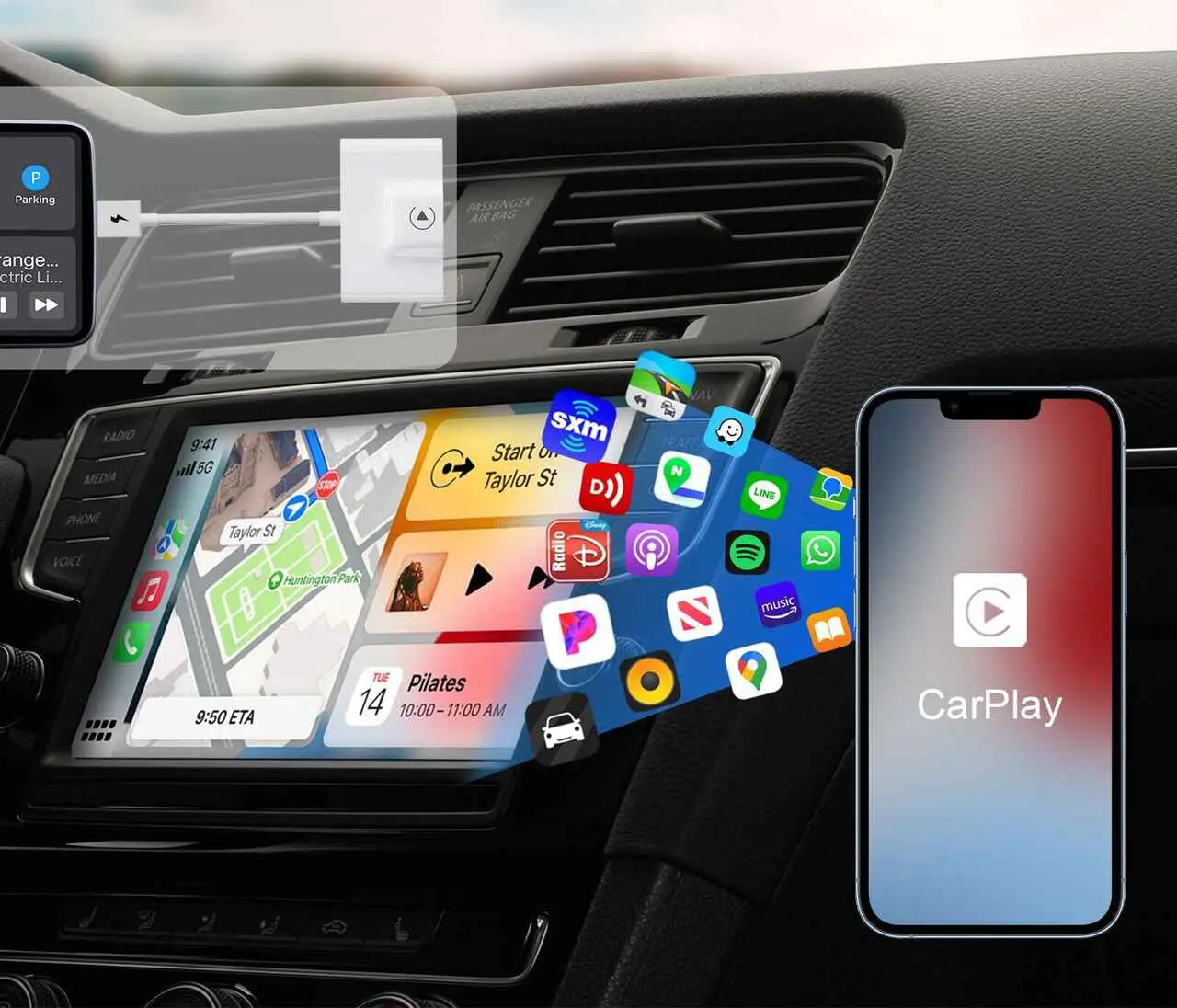Putting your car into motion, plugging in your iPhone, and hitting the road with Apple CarPlay is a joyride worth taking. But sometimes, even the smoothest journeys hit a speed bump when your CarPlay crashes. So, you’ve just updated your iPhone to iOS 16, eagerly anticipating all the exciting new features and improvements. But wait, what’s this? You notice your phone charging, but CarPlay is not working on iOS 16! Now, how will you make the most of your phone during those never-ending road trips?
If you’re stuck with glitchy Apple CarPlay after updating to iOS 16, don’t slam on the brakes just yet. By using this guide, you will be able to determine the causes of the iOS 16 CarPlay crash. We will also provide you with some tried and true solutions for troubleshooting this problem so that you can get your CarPlay up and running again. So, let’s get started!
Why Is My iOS 16 CarPlay Not Working After Update?
Many users have reported that their Apple CarPlay was not working after the update. You might also be wondering why your CarPlay suddenly went from cruising smoothly to crashing after the iOS 16 update. We’ve identified some frequent factors that may contribute to this problem, so don’t worry.
Reasons For iOS 16 CarPlay Crash
There might be several reasons why your CarPlay suddenly stopped working on your iOS 16. A few of them are discussed below:
Problems with the CarPlay App or iOS Version
Sometimes, a bug may find its way into the CarPlay app or the phone itself, leading to a frustrating crash. These bugs pose a major obstacle to establishing a smooth connection between the app and your iOS device.
Geographical Restrictions
Contrary to popular belief, CarPlay is limited to specific countries, with several regions lacking support for this feature. So, if you’re traveling across different regions or countries, CarPlay might throw a fit and decide not to work.
Siri Turned Off
For CarPlay to function properly, it’s essential to have Siri’s hands-free functionality enabled on your iPhone. If Siri is turned off on your device, CarPlay might wave a white flag and surrender.
Incompatibility with the Vehicle or the iPhone Model
Compatibility issues can be a real roadblock when it comes to CarPlay. The feature is exclusively compatible with iPhone models from the iPhone 6 series onward. In case you’re unsure about your vehicle’s CarPlay compatibility, it’s advisable to confirm it with the manufacturer. If your car and iPhone are not speaking the same language, it’ll result in a crash.
Connection Errors
Sometimes, the connection between your iPhone and your vehicle’s infotainment system can become wonky, leading to CarPlay freezing (iOS 16). The cause of the issue could be either a malfunctioning USB or a deactivated Bluetooth connection.
10 Solutions for iOS 16 CarPlay Not Working
Now that we’ve identified the potential culprits behind the iOS 16 CarPlay crash, it’s time to roll up our sleeves and fix the issue. Buckle up because here are ten solutions to get you back on the road:
1. Verify the Vehicle’s CarPlay Support
The initial step is to ensure that your vehicle is capable of supporting CarPlay. Not all vehicle models or manufacturers offer Apple CarPlay as a feature. Especially if you possess an older vehicle, it is probable that you will not be able to utilize CarPlay. Double-check your car’s manual or contact the manufacturer to confirm whether your car supports this feature or not. You can also refer to Apple’s comprehensive list of CarPlay-supported vehicles to confirm it. You wouldn’t fit a square peg into a round hole, would you?
2. Make Sure CarPlay is Not Restricted on Your iPhone
If your iPhone isn’t being detected by Apple CarPlay, it could be due to restrictions placed on your iOS 16 device. While you’re at it, make sure restrictions aren’t playing spoiler by limiting CarPlay functionality. A few taps and tweaks might just bring back harmony between your car and phone.
Follow these simple steps to check:
- Launch the Settings app on your iPhone.
- Access “Screen Time” from the General settings.
- Choose the “Content & Privacy Restrictions” option.
- Click on Allowed Apps.
- Confirm that the toggle switch next to CarPlay is enabled.
- Otherwise, enable the switch to remove restrictions.
3. Check the Connections
Before we go tearing down the highway of more complex solutions, let’s proceed with the basics first. Make sure your iPhone is securely connected to the USB port in your car. A loose connection can throw a wrench in the works. Give the USB cable a good look. Make sure it is snugly connected and not damaged. It’s like checking your seatbelt before hitting the road—you don’t want it to come undone in the middle of a bumpy ride!
When using Apple CarPlay wirelessly, make sure that Bluetooth is turned on.
- To access your Bluetooth settings, go to Settings > Bluetooth.
- Toggle the switch to activate Bluetooth.
- It is also crucial to check that Airplane Mode is not turned on on your phone, as this will disable all wireless features.
- If the Airplane Mode toggle is enabled, you can disable it by tapping it once.
4. Restart Your iPhone and Car
When technology goes haywire, sometimes a good ol’ reboot is just the ticket. Give your iPhone a rapid restart and show it who’s boss. This quick off-and-on is like a power nap for your phone, refreshing its weary circuits. While performing this task, why not also allow your vehicle to rest for a bit? Turn it off, count to ten (or twenty if you’re feeling ambitious), and turn it back on. A fresh start might just clear out the gremlins causing CarPlay to sputter.
5. Update Your iOS
CarPlay can sometimes be incompatible with an outdated operating system. Apple frequently releases updates that address bugs, glitches, and compatibility issues. So, if you’re experiencing CarPlay issues on iOS 16, it’s crucial to ensure that you have the latest iOS version installed. It’s like giving your iPhone a tune-up, ensuring it’s equipped with the most recent fixes and improvements.
To update your iOS, follow these simple steps:
- A secure and reliable Wi-Fi connection is essential for your iPhone.
- Open the Settings app on your iPhone.
- Scroll down and tap on “General.”
- Select “Software Update.”
- If there is an update ready, select “Download and Install.”
- Then, comply with the instructions displayed on the screen to finalize the updating procedure.
6. Re-configure CarPlay
If CarPlay is acting up, it might just need a little reconfiguration. All you’ll need to do is remove the connected CarPlay from your device and set it up again. Here’s how:
- Go to CarPlay > Configuration > General.
- Delete your available CarPlay profile by selecting your vehicle and tapping on “Forget this vehicle.”
- Then reconnect it. Navigate to CarPlay and select your vehicle from the “Available vehicles.”
- Finally, reconfigure CarPlay and give it a test drive.
7. Get Rid of USB’s Restrictive Mode
To ensure data security, iPhones automatically deactivate the USB accessory if the device remains inactive for over 60 minutes. This is called USB’s restrictive mode by Apple. However, it can be a real party pooper, causing CarPlay to crash. Disable this mode by going to your iPhone’s settings, selecting “Face ID & Passcode” or “Touch ID & Passcode,” entering your passcode, and turning off the “USB Accessories” toggle.
8. Turn Off VPN
Using a VPN (Virtual Private Network) could potentially disrupt the connection between your car and your iOS device. In fact, many users have reported issues with their CarPlay functionality on iOS 16 when VPN is turned on. You can turn off your VPN temporarily and see if that solves the problem.
9. Adjust Network Settings
Making some adjustments to the network settings can sometimes solve the problem. By “adjusting,” we mean restoring your network settings to their original default configurations. Here’s how you can do it:
- Go to your iPhone’s settings.
- Select “General” from the menu.
- Scroll down and tap on the “Transfer or Reset iPhone” option.
- Tap “Reset” and finally choose “Reset Network Settings” from the options.
Please note that performing this action will delete your Wi-Fi passwords, so make sure to have them readily available.
10. Make Sure Siri is Enabled When Locked
As we discussed earlier, it’s crucial to have Siri’s hands-free functionality activated on your iOS 16 to ensure the smooth operation of CarPlay. Ensure that Siri is enabled even when your iPhone is in a locked state. To do so:
- Navigate to your iPhone’s settings app.
- Scroll down and choose “Face ID & Passcode” or “Touch ID & Passcode.”
- Enter your passcode.
- Activate the “Allow Siri When Locked” toggle.
The Bottom Line
Technology can be a finicky beast, but with a little patience and perseverance, you’ll triumph over the bumpy roadblocks. When your iOS 16 CarPlay crashes, don’t let it put the brakes on your road trip adventures. With the above troubleshooting tips in your back pocket, you’ll be cruising down the digital highway in no time. By following these solutions, your Apple CarPlay will be back on track in no time. Remember, it’s all about troubleshooting, reconnecting, and making sure everything’s in sync. So, put on your problem-solving hat and get ready to enjoy a smooth and glitch-free CarPlay experience!




